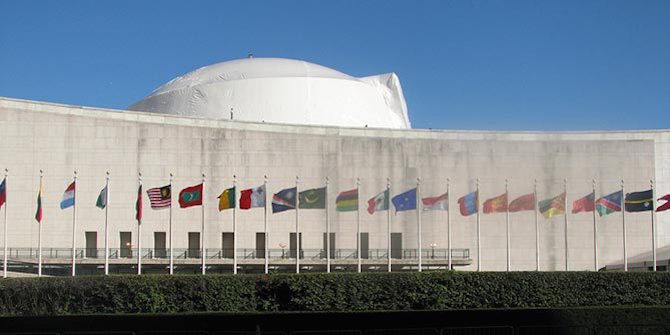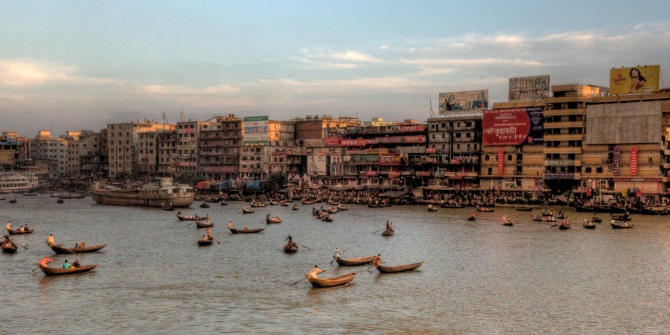 Shabana Shiraz reviews the NDA’s performance on urban development to date, and argues that the real progress is not linked to the much-vaunted 100 Smart Cities campaign but instead to the continuation and deepening of existing urban programs and the increasing integration of urbanisation policy.
Shabana Shiraz reviews the NDA’s performance on urban development to date, and argues that the real progress is not linked to the much-vaunted 100 Smart Cities campaign but instead to the continuation and deepening of existing urban programs and the increasing integration of urbanisation policy.
This article forms part of our Modi’s Government 1 Year On series.
Brand Modi built around the idea of India’s unprecedented economic growth was supported by a neo-liberal discourse of development; the 100 Smart Cities campaign has been established as an important part of this project. Inspired by the Gujarat development model of opening markets, introducing bullet trains and increasing the competitiveness of cities, this campaign (along with abysmal performance of the UPA governments) appealed the masses who bought into this transformative idea. One year into Narendra Modi’s government, if one considers how much of this transformation has been delivered, the answer would be moderately negative. 365 days in no way are enough to judge the mettle of the new government viz. Its urban agenda, however, its a pretty good indication of things to come. Aside from the campaign for 100 smart cities, most of the urban development programs proposed are just re-branded versions of old ideas, with an increased emphasis on decentralisation (seen as a critical ingredient in the Gujarat model). It may be disappointing for people waiting for a complete transformation, but for the purpose of deepening of reforms, this continuity is in fact a welcome move.
The two most important urban programs that have been approved by the union cabinet are the ‘100 Smart Cities’ and ‘Atal Mission for Rejuvenation and Urban Transformation’ (AMRUT). On a closer inspection however, AMRUT is a mere re-naming of the erstwhile JNNURM (Jawaharlal Nehru National Urban Renewal Mission) program that aimed at reform based infrastructural improvements in the cities, the only difference being greater autonomy to the states with respect to screening of projects. Pending release of implementation details, it would be encouraging if AMRUT acknowledges and plans around lessons learned in JNNURM, such as the missing link between habitats, infrastructure and livelihoods, and the need for further institutionalising citizen participation in urban planning and management.
The flagship ‘100 Smart Cities’ program, the concept note for which received criticism for creating non-democratic techno-managerial utopias, is now increasingly advocating citizen participation as a means for identifying projects, although how and when will this materialise is yet to be seen. The selection criteria for a city to be shortlisted by the State government for the smart cities project have an inherent capacity bias and selection is based on the ability of a city to improve the quality of life of its citizens. On the other hand, MoU (memorandum of understanding) is being signed with foreign philanthropists to aid in selection of cities and technology giants are making their own strategic selections. This involvement may undermine a rational, more needs based selection process. In contrast, programmes like Heritage City Development & Augmentation Yojana (HRIDAY) and Swachh Bharat Yojana (Clean India Campaign) have remained focused on needs identified during the implementation of JNNURM and its capacity building initiatives.
However, commenting on the tone of future urban development, solely on the basis of urban programs is rather simplistic, as it undermines its growing nexus with other socio-economic and political institutions. A fertile ground is being created for strengthening political decentralisation and social inclusion. The creation of NITI AYOG (to replace The Planning Commission of India), which grants greater powers to the States in national policy making combined with increased autonomy in project selection under AMRUT urban program, is a step forward on decentralisation. Furthermore, an array of social safety schemes such as Pradhan Mantri Jan Dhan Yojana (Prime Minister’s People Money Scheme), Atal Pension Yojana (Pension Scheme) and Pradhan Mantri Suraksha Beema Yojana (Accidental Insurance Scheme) promise to offer financial inclusion, financial security and medical insurance to those employed in the unorganised sector and daily wage earners. Apart from cushioning those likely to be excluded from the liberal economic reforms, these shall also provide inclusion and protection benefits to the most vulnerable urban populations (especially the urban poor) who are engaged in informal economic activities like domestic help, car drivers, street vendors, to name a few.
Although fragmented, the combined impact of continued deepening of political institutions of decentralisation and participation through AMRUT along with social inclusion offer an incremental, stable and safe (non-risky) pace of urban development. What is worrying is the capture of urban development discourse by neo-liberal ideologies being increasingly perpetuated by the smart-cities agenda. This discourse is not only shaping the vision of future cities, but is also giving rise to new urban epistemological communities, solely characterised by expertise and technical knowledge, which in turn are shrinking the space for grass-roots participation and local knowledge. That citizens have to demand the rights to their cities through a campaign is an illustration of this shrinking of space. One cannot undermine the fact that urban development is an important conduit to further the great economic leap envisioned by India, and maintaining the competitiveness of Indian cities is important. However, this does not mean that market rationalities – rather than social rationalities – should rule urban programs and discourse. Priority should instead be given to calls for defining a vision, identifying challenges and setting priorities that do justice to national aspirations as well as those of the most vulnerable inhabitants.
The case for an integrated urbanisation policy has never been stronger. The common leadership of the Ministry of Urban Development and the Ministry of Housing and Urban Poverty Alleviation along with the potential implications of non-urban programs and schemes make a strong platform to begin crafting a national urban policy. For those hoping to witness a transformative change, this is the shift to look out for.
Cover image credit: flickr/Premshree Pillai (CC BY-SA 2.0)
Note: This article gives the views of the author, and not the position of the South Asia @ LSE blog, nor of the London School of Economics. Please read our comments policy before posting.
About the Author
 Shabana Shiraz is an urban practitioner with a keen interest in participatory pro poor urban planning and governance. Her perennial fascination for cities and its people has prompted her to be actively engaged in research and dialogue revolving around exploring how both these can work towards the benefit of each other. She is currently studying for an MSc in Development Management at LSE.
Shabana Shiraz is an urban practitioner with a keen interest in participatory pro poor urban planning and governance. Her perennial fascination for cities and its people has prompted her to be actively engaged in research and dialogue revolving around exploring how both these can work towards the benefit of each other. She is currently studying for an MSc in Development Management at LSE.
Read previous posts by Shabana here.







